John Bagnall: Cor, Endless Possibilities
Posted: Tuesday, September 21, 2004
By: Darren Schroeder
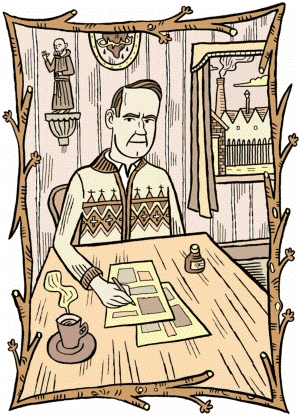
Small press comics are taking over the world, honest. There I was taking some time off from reviewing comics by indulging my weakness for David Bowie news when I see a familar name from my comic reading. John Bagnall's recently published collection Don't Tread On My Rosaries includes his version of David Bowie's diary from his Berlin days. Now I've picked up the occasional piece of John's work in the past and always enjoy the quirky drawings and light-hearted view of life in the UK, so figured I should exploit chance and track him down to find out some more about him and his work....
Darren Schroeder: What is your full name?
John Glen Bagnall. The first two were suggested by my Grandma, in tribute to the American astronaut John Glen, so I'm most definitely a child of the space age.
DS: What is your age?
JGB: Old enough to remember American astronauts.
DS: Were comics a big part of your childhood or did you discover them at a later stage?
JGB: Comics feature vividly in my childhood memories. British kid'stitles like Beano, Dandy, Wham and Smash included funny, anarchic work by great cartoonists like Leo Baxendale but I also loved more gentle, archetypally English newspaper strips like Rupert the Bear. In my teens U.S Marvel and DC comics dominated. I haven't really read superhero comics in years but am still in complete awe of Jack Kirby and Steve Ditko. You can't beat Kirby's machines and monsters or Ditko's psychedelic inventiveness in Dr. Strange.
DS: Are these awe inspiring in terms of the comics field or a wider sense?
JGB: Old time comic pros of Kirby & Ditko's calibre are awe-inspiring in many ways: amazing graphic facility, mammoth productivity and, at their peak, their work excites the imagination like few other art forms can.
DS: Was art an important part of your education?
JGB: I don't remember this but my parents must've been very tolerant of my scribbling instincts as I was allowed an area of the living room wallpaper to scrawl on. As for formal education, one time in primary school the teacher asked me to hold up my painting (of Frankenstein I think) and the rest of the class applauded. For a shy youngster formative gratification like that might've helped to set me in an artistic direction. One of my secondary school art teachers had been to art college in the late '60s and she made it sound so happening and groovy I eventually couldn't resist applying. My first choice was Newcastle, where Roxy Music's Bryan Ferry had studied, but by the time I got there any swinging or even glam eras were well over.
DS: What was the first comic you published yourself and how did that come about?
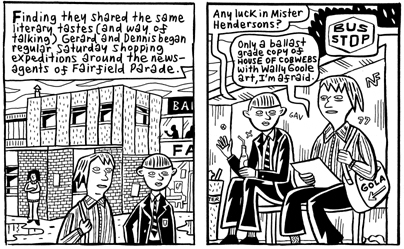 |
DS: Is there any common theme to your work?
JGB: My strips are very rarely set in the present day, usually some time in Britain between the 1950s and the end of the 70s. I like to observe vanishing regional oddities, places drawn from memory and the weirder folk fringes of Roman Catholicism. I also have a tendency to use real life characters in fictional settings e.g. David Bowie and Padre Pio, the stigmatic saint. Hopefully humour is also a common factor in my work!
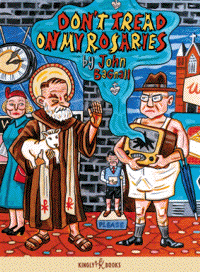 DS: the weirder folk fringes of Roman Catholicism... as evidenced in your Don't Tread on my Rosaries trade paperback. Is that because you are 'dealing with your issues' in your work or is religion just full of funny things?
DS: the weirder folk fringes of Roman Catholicism... as evidenced in your Don't Tread on my Rosaries trade paperback. Is that because you are 'dealing with your issues' in your work or is religion just full of funny things?JGB: Well, I have to distinguish between theology, which is a long time interest and some of the popular "folk"expressions of religion, which have worked their way into my subject-matter. These are not only funny ha-ha but funny peculiar. Certain devotions and cults of the Virgin Mary and Saints (like Padre Pio) have a bizarre, obsessive side, are full of rich imagery and are endlessly fascinating to me. Last year I went to Fatima (RC shrine in Portugal) and one of the first things I saw was a middle aged woman walking past me on her knees. Maybe I enjoy putting my characters through the same sort of suffering!
DS: The piece on Bowie is a laugh - have you been a dedicated Bowie fan for a while?
JGB: All of the Thin White Duke's records until the end of the 70's are uniformly great. It doesn't matter that he hasn't produced anything of similar quality since because we expect too much of our aging pop stars. His Berlin period has always intrigued me, it's so mysterious, so when I based a strip on it I had a lot of fun just making things up. One of the Bowie websites recently picked up on the story and were talking about sending a copy to the man. I've been waiting by the phone ever since but David hasn't called me to do his next CD sleeve yet.
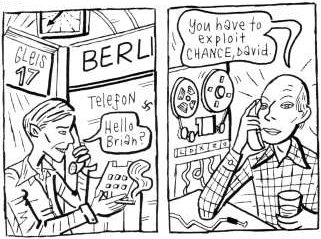 DS: Well, I saw him play live in February and he he still knows how to rock without taking things too seriously.
DS: Well, I saw him play live in February and he he still knows how to rock without taking things too seriously.JGB: I'm sure he can still pull off a great performance but I just don't think you can expect that amazing degree of invention and re-invention of his heyday anymore.
DS: How did you distribute your comics?
JGB: When I first started self-publishing Trashcan and solozines I became involved in the UK Fast Fiction network, which sold small press comics via mail order lists and the bi-monthly comic marts at Westminster Hall, London. This wasin thelate 80s and introduced cartoonists like Eddie Campbell, Glenn Dakin, Ed Pinsent, Carol Swain, Woodrow Phoenix and Chris Reynolds. Most of us eventually had strips published in Paul Gravett's Escape magazine. More recently I've sold self-published comics through websites like my own, Kingly Books and Small Zone.
DS: What were those Bi-monthly comic marts like - hundreds of avid customers or a few dozen comic creators buying each others work?
JGB: Well, I could say the marts gave the small press of that time visibility and bigger sales but you're quite right in guessing the most important aspect was social - what happened in the pub afterwards. Meeting like mindedyoung creators andcatching up withtheir new work every couple of months was very positive. Many of the people I met then are still close friends today.
DS: Are you going to any comic conventions in the near future?
JGB: In the very near future no but I hope to be at New York's Mocca Convention in June 2005.
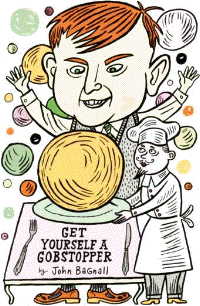 DS: How often do you put out mini-comics such as your latest, Get Yourself a Gobstopper?
DS: How often do you put out mini-comics such as your latest, Get Yourself a Gobstopper?JGB: I was planning to do four minis in 2004, as I still get a kick out of the total control of self-publishing. But it looks like after Double Woodwork I'll only be able to fit in one more before Christmas. They'll all be available from my website.
DS: How many copies do you get printed?
JGB: Only 100 of each, so snap 'em up folks!
DS: What is the worst experience you've had with an editor?
JGB: No names... but an Australian publisher was once going to print a collection of my stories. This eventually fell through yet he showed no interest in returning my original artwork. My other experiences have been more positive, I'm glad to report.
DS: Materials and equipment?
JGB: I'm comfortable using good heavyweight A3 cartridge paper, as Bristol Board feels too smooth. For drawing and lettering I use a combination of No.2 brush with Indian Ink, Pentel Sign Pens and Rotring Art Pens. For illustration work I modify and colour scanned artwork with Adobe Photo Shop. I also paint in acrylics. The cover of Don't Tread On My Rosaries book was produced this way.
DS: Target Audience?
JGB: I try not to think about it as I think a lot ofcrummy, cynicalwork gets done trying to fit some niche market i.e. the current glut of Gothinclined comics. At this point I'm happy just to continue to write and draw for my own pleasure, though I think my more humorousstuff like Disappearing Phrases could appeal to a non-specialised readership, perhaps to people who don't frequent comic shops very often.
DS: What work have you been doing recently?
JGB: Some illustrations for a new music magazine called Plan B and trying to finish a self-published comic to be called Double Woodwork.
DS: What comics have you read recently?
JGB: I'm still working my way through the big hard back McSweeney's Quarterly that Chris Ware edited. A lot of my favourite cartoonists are in there like Ben Katchor, Lynda Barry and Panter. Also The Dial collection by mysterious Welsh genius Chris Reynolds, it seems different every time I read it.
DS: If a song was made about your current state of mind who should sing it?
JGB: I can think of one very specific song: End Of The Season by The Kinks, from their Something Else CD/LP. Summer is nearly over, the shops are full of "Back To School" signs and I'm feeling slightly wistful. Ray Davies captures that mood perfectly.
DS: Ray Davies' songs and his autobiography (X-Ray) deal a lot with a similar examination of what Britain was like in that period. Is your interest based in a feeling of regret that things have changed for the worst, which seems to be Davies' approach, or a more neutral response?
JGB: When I listen to a song like Village Green Preservation Society I get the impression Ray Davies thinks things have changed for the worst yet preservation and revival is impossible and even absurd. I have a similar strong affection for the periods in which I set my strips but I would hate their purpose to appear to be some sort of overt polemic or argumentthat the past is superior. Someone like Robert Crumb is definitely making a vociferous point on these matters - he certainly wants you to know that he thinks 1920 Dance Bands are better than Bruce Springsteen or that rural living is preferable to modern city life. I prefer to leave things open to interpretation, and use nostalgic settings as the stages on which my characters play.
DS: I tried to think of some New Zealand disappearing phrases but none came to mind. What's your favourite disappearing phrase?
JGB: I bet you could come across some fine disappearing phrases in NZ old people's homes. Linguists say spoken language is now much less regional because of the influence of TV etc. but I'm happy to say you can still hear a good disappearing phrase here in good old Northern England. All the phrases I illustrate are absolutely genuine and I love it when I hear a new one. For example, "He couldn't stop a pig in a passage" would be used to describe a bow-legged man and "He's got more spots than a painter's radio" for a poor acne-sufferer. My current favourite is "Your handwriting is like a Chinese doctor's sick-note". No doubt a lot of sarcastic school-teachers have used that one.
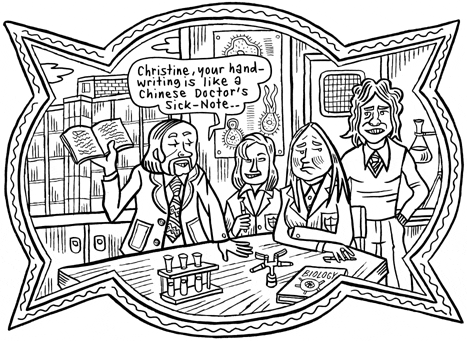
DS: What's the most common response when you tell new accquaintances that you create comics?
JGB: Some people are curious then ask if there's any money in it. When I say hardly any compared to the amount of labour that goes into them they wonder why I don't go into animation or do more illustration work. A lot of other people still seem to think comics are not only for the slightly retarded but also created by the slightly retarded. But I carry on regardless.
DS: How did that rumour get started and what can we do to combat it?
JGB: I suppose it's what you might call the geek factor, partially based onobservation and partially on stereotype, that comics fans are inadequate males living out dodgy wish fulfilments in lowbrow reading matter which is created by similar types. I try not to agonise about it too much because there are no instant solutions. Getting books sold outside specialist comic outletshas to help and you would think the success of Jimmy Corrigan etc.might make publishers take note but mainstream publishers are incredibly cautious and conservative.
DS: Regarding doing more animation/illustration work, what is your response to that question?
JGB: I tell them I don't do comics for the money. Blank stares then follow. Truth is I think the comics medium has endless possibilities.
DS: Are those possibilities being utilised at the moment?
JGB: Not fully, but when I visit a comic shop today much of the stock is more varied in format and content than it was, say, 10 years ago. Slightly less American dominated also. Other cultures have made inroads, even if it's just the current popularity of Manga.
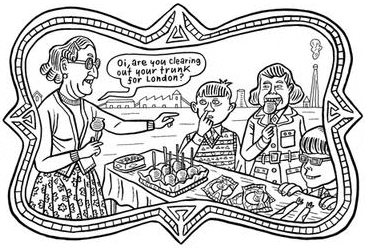 DS: Do you have a sense of how well international audiences "get" the Englishness of your work?
DS: Do you have a sense of how well international audiences "get" the Englishness of your work?JGB: Reactions are mixed. One American reader thought I created a "postwar British vibe" very well while another said he appreciated the sensibility but feared my work might be too drab or "blah" for non-English readers.
DS: Is my memory correct when I recall seeing some of your work appearing in the Fox anthology?
JGB: That's right. Fox comics published quite a healthy balance of British, Australian and New Zealand cartoonists. Didn't Dylan Horrocks have some of his earliest stuff printed in Fox?
DS: Yes it seems he did, he lists the 30 page contribution Sex on his website - How did you get involved with Fox?
JGB: Fox must've been casting their net wide because they picked up on the UK Small Press and Escape magazine "scene" pretty much as it started and were regularly publishing Eddie Campbell, Phil Elliott and Ed Pinsent. I can remember Ed showing me a letter from these Australian geezers who were wondering if I'd also be interested in contributing. Not long after they went magazine size and I know I designed one of their wrap-round covers, among other things.
DS: How would you describe your drawing style?
JGB: My favourite description is "pleasantly musty", a phrase coined by Anne of the wonderful I LIKE website.
DS: Cool site. Pleasantly musty.. yeah, that works really well. What was the last place you went that had a musty feel?
 |
DS: Wow - now that's a classy place to visit. Have you ever wanted to throw someone off the side of a building? If so, who and why?
JGB: Er, I'd usually be too busy getting dizzy with vertigo. But now you come to mention it...there's this presenter/DJ on British TV and radio called Jo Whiley who really gets on my nerves. If there's anything remotely 'indie' she's always on and she's useless, just preens and poses and has this annoyingly mannered 'cool' style of delivery. I'd give her the push just so somebody else could have some air-time for a change.
DS: Where are the buildings shown in the New Town Centre strip from
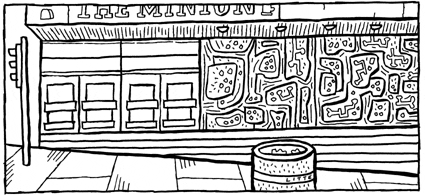
JGB: Some photos I found of 1970s shopping precincts in my home town Liverpool and also Portsmouth.
DS: What caught your eye about them?
 |
DS: How do you think your style has developed over time?
JGB: Less "punk" and scrappy and a lot more pre-meditated and considered. I now spend much more time on pencilling and thinking about layout and pacing. For the 27 page Chemist & The Capuchin story I researched period cars, buildings and clothes so the atmosphere would be authentically 1955. Having said that, I can't see my style ever becoming super-slick.
DS: What's the hardest thing to draw for you?
JGB: Definitely animals. Some old fellow discovered I was 'arty farty' and kept asking me to do a pencil portrait of his pet Yorkshire Terrier. I eventually agreed but I'll never forget the look of disappointment on his face when I handed over that drawing...
Our thanks for John taking the time to answer some questions. For more information and ordering details check out the following links.
http://johnbagnall.mysite.freeserve.com
http://www.kinglybooks.com
Reviews at SBC:
A Nation of Shopkeepers
Farnkly #4 (Anthology)
If you have a comment or question about Small Press then feel free to contact me